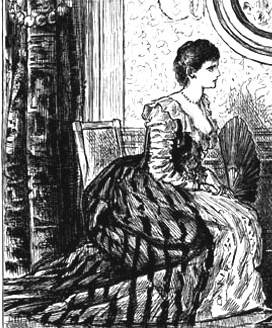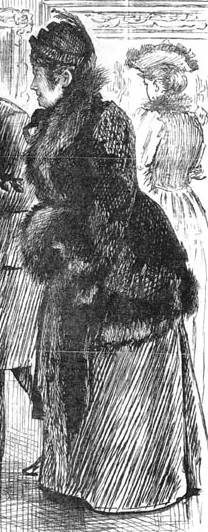The author has graciously shared with readers of the Victorian Web this passage from the second edition of her Fashion in Costume, 1200-2000 (2000), published by A & C Black (Publishers) Ltd., which retains copyright. Readers wishing to obtain the book can e-mail the following address: sales@acblack.com.
 en's clothes became even more sober in colour; the darkish blues, light fawns and plaids for trousers of the 1850s and early 1860s faded by the 1870S into a general range of grey and black, with broadcloth as the favourite fabric, perhaps slightly relieved by a rare flash of colour in a necktie, and by check tweeds for country suits or plaid for an Inverness caped coat. Silk was still used occasionally, in a ribbed form for waistcoats, and for linings and some facings. Variations during the 1890s included fabrics such as linen, duck, pongee or seersucker in lighter fawns, beige or white for summer wear, and white flannels and brightly coloured wool blazers for sport, but for town or formal wear dark grey or black in woollen cloth remained correct.
en's clothes became even more sober in colour; the darkish blues, light fawns and plaids for trousers of the 1850s and early 1860s faded by the 1870S into a general range of grey and black, with broadcloth as the favourite fabric, perhaps slightly relieved by a rare flash of colour in a necktie, and by check tweeds for country suits or plaid for an Inverness caped coat. Silk was still used occasionally, in a ribbed form for waistcoats, and for linings and some facings. Variations during the 1890s included fabrics such as linen, duck, pongee or seersucker in lighter fawns, beige or white for summer wear, and white flannels and brightly coloured wool blazers for sport, but for town or formal wear dark grey or black in woollen cloth remained correct.
Conversely, the range of fabrics and colours widened for women, but it is important to appreciate how different the pure silks, cottons and woollens were from those of today, which so often have synthetic threads or crease-resistant agents added. Taffeta, for instance, had a beautifully crisp, light quality which made it particularly suitable for bouffant styles; satin, backed with silk or cotton, was almost firm enough to stand on its own, unlike many of the soft, rather limp satins today.
Throughout the period light colours were fairly general for evening wear and were considered more suitable for young ladies, as were cottons like muslin or taFlatan, but by the 1860s cotton had lost ground as a high-fashion fabric, and silk, satin, taffeta, faille, moiré, silk poplin from Ireland, and velvet for more mature ladies, were used for formal dresses. Many of the softer colours, both pale and dark, of vegetable dyes gave way to those produced by the new aniline dyes -- strident magenta, electric blue or vivid yellow, often contrasting harshly in one outfit during the 1870s-80s; but softer, more muted colours also appeared in the fine soft woollens such as delaine, a cloth resembling cashmere but with a silk warp or weft, and in the more mannish serge or tweeds used for tailored suits and dresses.
Brightly colored striped fabrics



Left Morning coat. Right: Frock coat (at left) and a jacket. [Click on these images for larger pictures.]
Liberty silks and the Eastern influence were gradually shifting the vogue towards subtle colours, but in general the 1890s presented an image of fairly bold colour and pattern with broad stripes, guipure lace, and passementerie braid with jet, although an increasing use of sheer fabrics such as mousselaine de soie (a fine chiffon) hinted at the softer style to come in the 1900s. Furs used for trimming, short jackets, hats and muffs were usually short-haired, such as Persian lamb, sealskin, beaver, sable and mink.
The use of fur




Except for the very poor who relied heavily on cast-offs from the well-to-do, the desire to be well and fashionably dressed increased considerably during this half-century. The sewing machine and the introduction of the commercial paper pattern, originally intended for dressmakers and tailors but quickly selling to the home dressmaker, the increasing number of magazines reporting and illustrating fashion from Paris, Vienna, London or New york, and a growing ready-to-wear trade, enabled a shop assistant or a maid-servant at the end of the 19th century on her occasional afternoon off to have quite an air of fashion about her, and her male escort took pride in being as fashionable as his pocket would allow and at least well brushed and with immaculate collars and cuffs. Unlike today, Sundays and Bank Holidays were regarded as an opportunity for dressing up and giving as great an impression of prosperity and wealth as possible. [166-167]
References
Nunn, Joan. Fashion in Costume, 1200-2000. 2nd edition. A & C Black (Publishers) Ltd; Chicago: New Amsterdam Books, 2000.
Last modified 11 June 2001